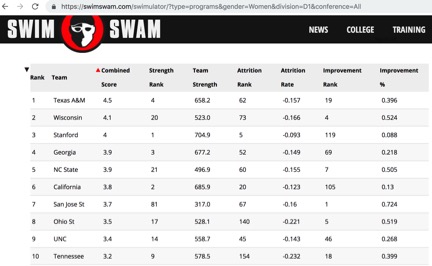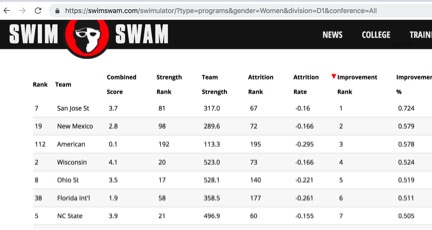By Sage Hopkins
PSE PRO Swim Head Coach
San Jose State Woman’s Swim Team Head Coach
Last year San José State swimmers improved more than any other Division I team in the country … this is our approach to swimming fast.
When asked to describe our program at San José State, the word I most often use is “holistic.” I go on to explain that we look to leave no stone unturned in the development of each swimmer and will teach them to train better, sleep better, recover better, deal with pre-race “nerves” better, etc. Our approach has proven successful and we have developed a reputation as a program where swimmers achieve continual time improvements throughout their collegiate career.
Last spring the website SwimSwam published a statistical analysis of each program in the country looking at a variety of metrics, with the composite rankings listing us as 7th, alongside many of the powerhouse programs within the NCAA:
With the programs ranked by improvement rates, San José State comes out on top:
Looking at every team in the country, our swimmers improved more than those on any other Division I team. While there are a multitude of factors that go into our improvement, the two primary ingredients to our success are:
• The integration of breath work into our program
• Our coaching and training philosophy
While future articles will cover each of these areas in greater depth, I’ve outlined some of the key concepts in each.
BREATHWORK
We first began playing around with various breathing protocols several years back, with a major integration of breathwork into our daily training over the past two years. Each swimmer has a variety of breathing protocols that can help in multiple areas including:
• Feeling anxious (pre-race, academic situations, etc.)
• Sleep
• Recovery
• Race performance
• CO2 Tolerance
Our breath work takes place in 4 separate areas: pre-practice, within training sets, post-practice and pre-sleep. While a future article will detail how we are integrating our breath work in each of the above areas, I can say that our swimmers have noted positive results in everything from the quality of their sleep, to a reduction in anxiety levels, to improved swimming performance.
COACHING AND TRAINING PHILOSOPHY
We look to balance the needs of the individual with the needs and goals of the program as a whole, something that can be a bit of a juggling act at times, especially in the age of the “millennial.”
Building trust and mutual respect is an essential part of getting athletes to “buy-in” to the program and the foundation of this trust and respect is making sure that the athlete knows the coaches “care” for them as individuals.
In terms of the “nuts and bolts” of our training program, we are what is known in the swimming community as a “quality based” program, meaning we put more emphasis on the quality of our training versus the “quantity” of yardage our swimmers cover.
Essentially we are swimming and kicking at high intensity in nearly every practice (the exception being our recovery days on Thursday). As odd as this may sound to many of you, we are a bit of an outlier in the swimming world in that we do not track volume of work in a traditional sense. While I will say this is an important thing to do early on in a coaching career, I have learned to trust my eyes and ears in terms of balancing our work and recovery.
While the overall goal is to get in as much productive work as we can, I always keep in mind the very valuable coaching advice I received from Mike Hastings who I had the honor to swim for, “never get the team so broken down that they can’t bounce back with 2-3 days of recovery work.”
Balancing work levels is a highly visual and sensorial concept for me … probably due to my background in visual arts, and I am always conscious to pay a “deep” level of attention to the body language, quality of movement, and composure of my athletes while keeping in mind to also “watch with my ears and listen with my eyes” to take in the whole picture.
Stay tuned for future articles that delve into the specifics of breath work and my coaching and training philosophy.


